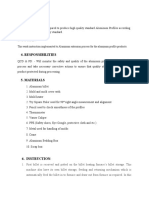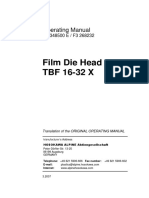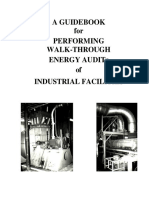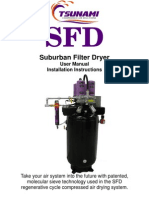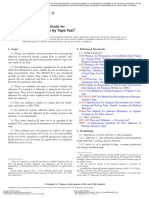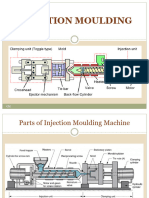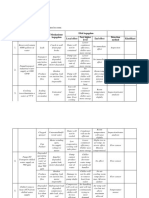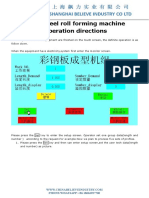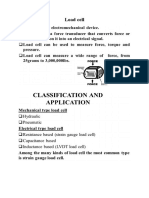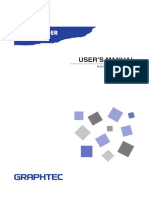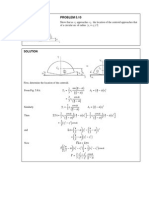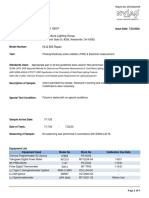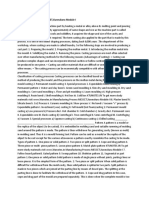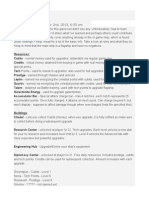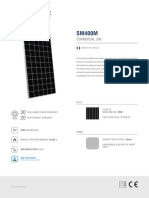Extruder Maintenance
Extruder Maintenance
Uploaded by
Ren Joseph LogronioCopyright:
Available Formats
Extruder Maintenance
Extruder Maintenance
Uploaded by
Ren Joseph LogronioOriginal Title
Copyright
Available Formats
Share this document
Did you find this document useful?
Is this content inappropriate?
Copyright:
Available Formats
Extruder Maintenance
Extruder Maintenance
Uploaded by
Ren Joseph LogronioCopyright:
Available Formats
Chapter 13
Extrusion Problems and How to Solve
Them
All Life is problem solving.
—Karl Popper
13.1 A Bit of Help for Self-help
Going back to Chap. 5, you will find a questionnaire which we have devised and
which will help to give you a fairly accurate idea as to the type of extrusion plant
you will need. This has been based on the assumption that you know the type of
raw material to be processed, the products to be made, in which quantities and the
working times including the major boundary conditions. There is another checklist
in Chap. 17 which should also aid you in verifying prior to your final decision
which of the short-listed extruders will best meet your particular requirements. Here
in this chapter, it is assumed that you are already involved with extrusion but are
now and again confronted with certain problems. The following checklist should
assist you in solving extrusion-typical problems by way of a systematic approach.
This list had to be restricted to the most significant cases which occur in practice. In
this connection, I would like to draw your attention to the section “Problems” in the
well-known book of James S. Reed, “Ceramic Processing”; in my 1995 edition,
page 473 et seq. Any specific problems which are related to your existing extrusion
plant should be addressed directly to the manufacturer of the extrusion equipment.
But any kind of problem solution necessitates the existence of reliable infor-
mation in respect of all relevant operating parameters such as extrusion pressure
rates, current consumption, degree of vacuum, column speed and torques.
Regrettably, this is in many cases not available!
Often enough we experience that a de-airing extrusion unit has functioned
absolutely perfectly for months after being delivered, and all of a sudden, more and
more problems accumulate for no apparent reason. We wonder why? Only in a few
cases, one receives satisfactory answers and, in the rarest instances, is informed of
changes that have been made since successful start-up of the plant, for example
modifications to the body, the condition of the wearing parts, variations in the
© Springer Nature Switzerland AG 2019 99
F. Händle, The Art of Ceramic Extrusion,
https://doi.org/10.1007/978-3-030-05255-3_13
100 13 Extrusion Problems and How to Solve Them
material moisture content. You may find that the suggested measures such as
checking of the wear rate of the auger and barrel liners repeat over and over again.
In reality, very diverse problems originate from just a few causes: rough auger
surface, variations in the moisture content of the prepared material, leaks in the
extrusion system, etc.
The following checklist assumes that the boundary conditions ahead and after
extrusion are right, which means that the dosing and preparation system upstream
of the extruder provides the required performance and also that the handling and, in
particular, the drying process downstream of the extruder are attuned accordingly
(Table 13.1).
Table 13.1 How to solve the problems in extrusion—a checklist
Problem Causes Remedy
Insufficient output Screw worn Refurbish or replace screw
Cylinder liners worn Replace or refurbish cylinder
liners
Surface of screws is too rough Polish the surface of the screw
and/or renew the hard-faced layer
Unadapted screw revolution—too Check whether it is possible to
fast or too slow adjust revolution of the auger
according to the required output.
Try to extrude “hungry”.
Check if the column speed reacts
linearly with the revolution of the
screw
Perforated plate and mesh in the Check perforated plate, replace as
pressure head create a too high needed/if possible, and check for
pressure drop blockage of perforated plate or
mesh
Inadequate geometry of the Check if the geometry is suitable
cylinder liners to stop rotation of the body
Inadequate geometry of the screw Check if the geometry is suitable
regarding output and pressure
generation
Material moisture level—too high Control the moisture content
or too low
Material sticks on the auger in the Polish auger, change geometry of
feeding zone the auger and control interaction
between auger and feeding roller
(continued)
13.1 A Bit of Help for Self-help 101
Table 13.1 (continued)
Problem Causes Remedy
Power consumption Surface of screws is too rough Polish the screw
and temperature of Inadequate geometry of the screw Check if the geometry is suitable
the motor—too high regarding output and pressure
generation
Motor and frequency converter Control function of motor and
are defect or not aligned frequency converter including
alignment
Material—too stiff Check the moisture content
Foreign objects in the screw Open extruder and clean
Oil with incorrect viscosity or Check oil type and contamination,
contaminated oil and replace as needed
Ambient temperature—too high Install oil cooler
Bearings defect Check the bearings and replace
Oil loss Defective seals at shaft bearings Replace shaft seals and races as
needed
Vacuum—too low Seal between cylinder and Check seals, and replace if
extruder case damaged necessary
Seals between pre-extruder/pug Check seals, and replace if
sealer and extruder damaged necessary
Holes in perforated sealing plate Use sealing plate with smaller
before vacuum chamber—too holes
large
Too little or wrong oil in the Refer to the operating manual of
vacuum pump the vacuum pump
Vacuum pump with insufficient Check vacuum pump
pumping speed and/or ultimate
pressure
Unknown vacuum loss Organize leakage control and
vacuum test (see Chap. 11)
Backflow in the Output of pug sealer—too high Adjust output of pug sealer to
vacuum chamber match the extruder
Fluctuating moisture of body Check the moisture content of the
body and adjust
Length/diameter ratio (L/D) of the Check the L/D ratio and adjust if
screw—too short necessary
Foreign objects in the die or Check die and remove foreign
perforated plate objects if necessary
Free cross section and/or pressure Control geometry of screw
drop of the die—too high
Dried material in the Leakage of the vacuum chamber Control vacuum chamber with
vacuum chamber leakage inspection device
Temperature in vacuum chamber Check temperature, and reduce
—too high (water evaporation) temperature or vacuum as
necessary
Vacuum too high or too low Use vacuum regulating valve
(continued)
102 13 Extrusion Problems and How to Solve Them
Table 13.1 (continued)
Problem Causes Remedy
Temperature of the Cylinder liners worn, and Replace cylinder liners, and
body—too high incoming temperature of the body control incoming temperature of
—too high the body
Screw surface—too rough or Polish screw or replace screw
screw worn
Revolution of screw—too high Adjust revolution
Ambient temperature or incoming Install adequate cooling of the
body temperature—too high screw and cylinder, and adjust
incoming temperature of the body
Pulsing column Screw worn Replace or polish screw
L/D ratio—too short Check the L/D ratio and adjust if
necessary
Fluctuating moisture of the body Check the moisture content of the
body and adjust
Revolution of screw—too high or Adjust revolution of screw
too low
Insufficient output of pug sealer Increase speed output of pug
sealer
Laminations in the Rotation of the screw is seen in Check geometry of the top auger,
extrudate (see the column and enlarge distance between top
Chap. 9) auger and die (equalizing zone)
Middle of the column advances Check geometry of the pressure
faster than sides head, enlarge distance between
top auger and die (equalizing
zone), and control angles in the
pressure head and die
Cuts on surface or rough extrudate Control geometry of pressure head
after drying and die, control grain size
distribution, and control drying
conditions
Distortion of the Die not aligned with the pressure Make sure that pressure head and
extrudate head die are aligned and centred
One-sided roughness of the Polish pressure head and die all
pressure head and/or die over
Deviation in the Shrinkage of the material was not Control the shrinkage of the body
required geometry of considered in the design of the or of the different bodies
the extrudate die, or shrinkage has changed
Extrudate expands after die Detect if and how much the body
because of the high elasticity of is elastic
the body
Revolution of the auger—too Adapt revolution of auger
slow or too fast
Undulating surface of the Provide equilibration zone after
extrudate die, calendering after extrusion
13.2 Conclusions 103
13.2 Conclusions
• Try to analyse and understand your problem before acting.
• Make sure the processes of extrusion including the function of the vacuum unit
are understood.
• Carefully study all the relevant manuals.
• Try to separate the influencing factors; i.e., do not fumble with several factors
simultaneously.
• Do not fix it if it is not broken.
• Mistrust your glorious experience.
• Study the relevant literature regarding “problem-solving” and “decision-making”.
Bibliography
1. R. Ackoff, The Art of Problem Solving (Wiley, New York, 1978)
2. J.S. Reed, Principles of Ceramic Processing (John Wiley, New York, 1995)
3. S. Shingo, Quick Changeover for Operators: The SMED System (Productivity Press,
New York, 1996)
You might also like
- Extrusion Work InstructionDocument3 pagesExtrusion Work InstructionIbrahim AbduNo ratings yet
- Chandrasekhar S. The Mathematical Theory of Black Holes PDFDocument667 pagesChandrasekhar S. The Mathematical Theory of Black Holes PDFBudhaditya Bhattacharjee94% (17)
- HVC Double Chamber Vacuum Packing Machine ManualDocument46 pagesHVC Double Chamber Vacuum Packing Machine ManualxtrahighgradeNo ratings yet
- John Deere Standard: Approved For Supplier DistributionDocument48 pagesJohn Deere Standard: Approved For Supplier DistributionRicardo VitorianoNo ratings yet
- Superga - Yarn SingeingDocument4 pagesSuperga - Yarn Singeinglieven.verraest6369No ratings yet
- Injection Molding Defects Causes RemediesDocument60 pagesInjection Molding Defects Causes RemediesMada PopescuNo ratings yet
- Micrometer List of Products Move To Other ProductsDocument47 pagesMicrometer List of Products Move To Other ProductsLenon LiriosNo ratings yet
- Metal Forming For 2025 & 2026 GATE ESE PSUs by S K Mondal (All Compiled Forming)Document101 pagesMetal Forming For 2025 & 2026 GATE ESE PSUs by S K Mondal (All Compiled Forming)kishu94737No ratings yet
- Film Die Head TBF 16-32 X: Operating ManualDocument57 pagesFilm Die Head TBF 16-32 X: Operating ManualFelipe Cappato Da CostaNo ratings yet
- Walkthrough ChecklistDocument49 pagesWalkthrough ChecklistLe'Novo FernandezNo ratings yet
- 9.2-Suppl.C AUDIT PLAN & SCHEDULE REVISION 4Document3 pages9.2-Suppl.C AUDIT PLAN & SCHEDULE REVISION 4Thế PhongNo ratings yet
- WI in Core Shop ProcessDocument1 pageWI in Core Shop ProcessVishal Mali100% (1)
- Warehouse &transportation ChecklistDocument13 pagesWarehouse &transportation ChecklistMustafa Ricky Pramana SeNo ratings yet
- Suburban Filter Dryer: User Manual Installation InstructionsDocument8 pagesSuburban Filter Dryer: User Manual Installation InstructionsMistysPartsNo ratings yet
- Iatf JulioDocument24 pagesIatf JulioCarlos GuachaminNo ratings yet
- Pet-Asept D enDocument17 pagesPet-Asept D enKhang TruongNo ratings yet
- Corrective Action Board CABDocument28 pagesCorrective Action Board CABSudhagarNo ratings yet
- Sop-Standard Operating Procedure: ObjectiveDocument4 pagesSop-Standard Operating Procedure: ObjectiveDivyashree PatilNo ratings yet
- Astm D3359Document9 pagesAstm D3359TEJAS GADKARINo ratings yet
- ASTM D 2983-04 Standard Test Method for Low-Temperature Viscosity of Lubricants Measured by Brookfie - 百度文库Document4 pagesASTM D 2983-04 Standard Test Method for Low-Temperature Viscosity of Lubricants Measured by Brookfie - 百度文库Jack DanielNo ratings yet
- Armstrong Svoemmervandudladere Katalog PDFDocument22 pagesArmstrong Svoemmervandudladere Katalog PDFShaheryar Akram Kang100% (1)
- What Is Injection Moulding ProcessDocument42 pagesWhat Is Injection Moulding ProcesssadiqusNo ratings yet
- Precision Measuring InstrumentsDocument24 pagesPrecision Measuring InstrumentsAbhi GhavatNo ratings yet
- Spray Booth User and Maintenance Manual 119.23Document36 pagesSpray Booth User and Maintenance Manual 119.23bondomargalitadze margalitadzeNo ratings yet
- Line Balancing TemplateDocument3 pagesLine Balancing Templatecelva mechNo ratings yet
- KSB Etabloc Installation ManualDocument66 pagesKSB Etabloc Installation ManualLokesh Modemz50% (2)
- ASTM D1746-15 透明度Document3 pagesASTM D1746-15 透明度q7drfz992cNo ratings yet
- E12001Document28 pagesE12001IqbalNo ratings yet
- Broiler Preventive Maintenance ChecklistDocument5 pagesBroiler Preventive Maintenance ChecklistFaysbuk KotoNo ratings yet
- II - Ipex Dimensional Manual - NEWDocument98 pagesII - Ipex Dimensional Manual - NEWAnonymous 1ykzuaxWgYNo ratings yet
- Calibration ManualDocument23 pagesCalibration ManualRobby Setiabudi TjangNo ratings yet
- Internal Audit Checklist QADocument5 pagesInternal Audit Checklist QARavi BaghelNo ratings yet
- D 6441 - 99 - Rdy0ndeDocument8 pagesD 6441 - 99 - Rdy0ndejhonNo ratings yet
- PultrusionDocument17 pagesPultrusionsyamlokNo ratings yet
- General Arrangement, AIR COOLED (R90-110) 23539836 GDocument7 pagesGeneral Arrangement, AIR COOLED (R90-110) 23539836 GCarlos JiménezNo ratings yet
- Compressor Service Procedures TestingDocument22 pagesCompressor Service Procedures TestingAhmed AzadNo ratings yet
- Objective Name of The Employee / Team DepartmentDocument6 pagesObjective Name of The Employee / Team DepartmentSachin SinghNo ratings yet
- Testing Facility of IS 17216Document1 pageTesting Facility of IS 17216DrMinakshi ShrivastavaNo ratings yet
- Air Compressor Monthly Inspection ReportDocument1 pageAir Compressor Monthly Inspection ReportVigneshwaraNo ratings yet
- FMEA AssignmentDocument3 pagesFMEA AssignmentFebrizalNo ratings yet
- Mixers and Related Equipments For Industrial UseDocument20 pagesMixers and Related Equipments For Industrial UseSonthi MooljindaNo ratings yet
- Operation Manual For The RX 29 ShakerDocument19 pagesOperation Manual For The RX 29 ShakerCarlos Esaú López GómezNo ratings yet
- 2013 Rework & Inspection KatalogDocument0 pages2013 Rework & Inspection Katalogidea.angelNo ratings yet
- Torque Machine Data Sheert PDFDocument16 pagesTorque Machine Data Sheert PDFHakim HakimNo ratings yet
- Air Compressor Maintenance ChecklistDocument1 pageAir Compressor Maintenance ChecklistgrantNo ratings yet
- PDI ChecklistDocument6 pagesPDI ChecklistchhotelalpalmkpNo ratings yet
- Manual of Metal Roofing Sheet Roll Forming MachineDocument8 pagesManual of Metal Roofing Sheet Roll Forming Machinenovo orderNo ratings yet
- What Is TorqueDocument6 pagesWhat Is TorqueadamtuongNo ratings yet
- Load CellDocument6 pagesLoad CellnikitaNo ratings yet
- Textiles - Determination of PH PDFDocument12 pagesTextiles - Determination of PH PDFMangalPandeyNo ratings yet
- Installing Machine Tools: Here's What To ConsiderDocument1 pageInstalling Machine Tools: Here's What To ConsiderMobile SunNo ratings yet
- Daikin Applies Products PDFDocument8 pagesDaikin Applies Products PDFHa CongNo ratings yet
- User'S Manual: MANUAL NO - GL240-UM-153Document150 pagesUser'S Manual: MANUAL NO - GL240-UM-153Ta100% (1)
- Kistler Cavity PressureDocument24 pagesKistler Cavity PressurewantamanualNo ratings yet
- Standard GageDocument104 pagesStandard GageOleh SmolovyiNo ratings yet
- Lean SpreadsheetDocument13 pagesLean Spreadsheetqais bakrNo ratings yet
- QS-WIN-1.1-0 Raw Material Receiving and IssuanceDocument4 pagesQS-WIN-1.1-0 Raw Material Receiving and IssuanceWilliam BautistaNo ratings yet
- Manual 121L AmBev SergipeDocument518 pagesManual 121L AmBev Sergipe4ph6k4y7zwNo ratings yet
- Kalamazoo Kc12ax (Ah 300h Am50)Document126 pagesKalamazoo Kc12ax (Ah 300h Am50)mattshanebrownNo ratings yet
- InjectionMoldingPrinciples Ebook XometryDocument29 pagesInjectionMoldingPrinciples Ebook XometryImane El BouchehatiNo ratings yet
- epet_fm_pg47_48Document2 pagesepet_fm_pg47_48Sridhar IyerNo ratings yet
- Biobase BSC PDFDocument90 pagesBiobase BSC PDFDexa Arfindo Pratama100% (1)
- PROBLEM 5.10: SolutionDocument11 pagesPROBLEM 5.10: SolutionMarco Moreno MoensNo ratings yet
- HLG 600 R Spec ReportDocument4 pagesHLG 600 R Spec ReportJohnNo ratings yet
- Liquid Pentrant TestingDocument55 pagesLiquid Pentrant TestingRamesh R100% (1)
- Manufacturing Process MESCETDocument22 pagesManufacturing Process MESCETSarvan P PNo ratings yet
- Viscosity, Black Holes, and Quantum Field Theory: Dam T. SonDocument23 pagesViscosity, Black Holes, and Quantum Field Theory: Dam T. Sonarp tiwNo ratings yet
- Cigweldaeb Weldskill 200acdc Inverter (S) 0-5206 - Ac PDFDocument88 pagesCigweldaeb Weldskill 200acdc Inverter (S) 0-5206 - Ac PDFChristian GuarinNo ratings yet
- Galaxy Legend - GuidesDocument13 pagesGalaxy Legend - GuidesVõ Việt NamNo ratings yet
- Peimar SM400MDocument2 pagesPeimar SM400MasepNo ratings yet
- Internal Mock MTC1 Set1 - 2024Document4 pagesInternal Mock MTC1 Set1 - 2024musinguzinelson87No ratings yet
- 3RDSEM REMOTE SENSING PRACTICAL FILEDocument42 pages3RDSEM REMOTE SENSING PRACTICAL FILEKusha Faujdar Geography HonsNo ratings yet
- DPP - 07 - Geometrical Optics NJ - 247Document4 pagesDPP - 07 - Geometrical Optics NJ - 247gaurankkingNo ratings yet
- Ku-Band Mini BUC (3W) PDFDocument2 pagesKu-Band Mini BUC (3W) PDFPundaleek KalloliNo ratings yet
- Thesis Statement For Wind TurbinesDocument8 pagesThesis Statement For Wind Turbinesdw9x1bxb100% (1)
- What Is A DC Shunt Motor?: Shunt Motor. The Main Difference Between DC Series Motor As Well As DCDocument3 pagesWhat Is A DC Shunt Motor?: Shunt Motor. The Main Difference Between DC Series Motor As Well As DCالموعظة الحسنه chanelNo ratings yet
- Compact Motors: Technical CatalogDocument20 pagesCompact Motors: Technical CatalogPartagon PowNo ratings yet
- PPC SPM 2023 k2 BHGN A No 5-7Document6 pagesPPC SPM 2023 k2 BHGN A No 5-7NORHEDAYAH BINTI MOHD JANI KPM-GuruNo ratings yet
- Study On Cable Stayed Bridge and Its AppDocument3 pagesStudy On Cable Stayed Bridge and Its AppDouglas OngomNo ratings yet
- Indesit Dif04Document14 pagesIndesit Dif04PIKO MOBNo ratings yet
- Transmission: Section 8A - ZF Marine Transmissions-HSW 63A, 63IV, 80ADocument10 pagesTransmission: Section 8A - ZF Marine Transmissions-HSW 63A, 63IV, 80AJorge SoberanoNo ratings yet
- Volcano Classic Instructions EN 2020.09Document48 pagesVolcano Classic Instructions EN 2020.09SamNo ratings yet
- Tangent Hyperbolic Nanofluid SignificanceDocument14 pagesTangent Hyperbolic Nanofluid SignificanceMuazzamNo ratings yet
- J.P. Srivastava Elements of Solid State Physics 2006Document29 pagesJ.P. Srivastava Elements of Solid State Physics 2006Amar Alansi100% (3)
- 385c EscavadoraDocument4 pages385c EscavadoraVenpulpo ZeñaNo ratings yet
- Aits 2223 PT II Jeea TD Paper 1 SolDocument17 pagesAits 2223 PT II Jeea TD Paper 1 SolTanman RajNo ratings yet
- First Law of ThermoDocument8 pagesFirst Law of Thermormm0415No ratings yet
- Final Junoon-e-Jee - Atomic Structures - 21 DecDocument184 pagesFinal Junoon-e-Jee - Atomic Structures - 21 DecAnshu BhawsarNo ratings yet
- Entrance Exam /grade XI Model Question: 2023: SOS Hermann Gmeiner School SanothimiDocument10 pagesEntrance Exam /grade XI Model Question: 2023: SOS Hermann Gmeiner School SanothimiRachit DangalNo ratings yet
- Voltage Transformers For Gas-Insulated Switchgears (Gis)Document12 pagesVoltage Transformers For Gas-Insulated Switchgears (Gis)Edil Derrick CastilloNo ratings yet
